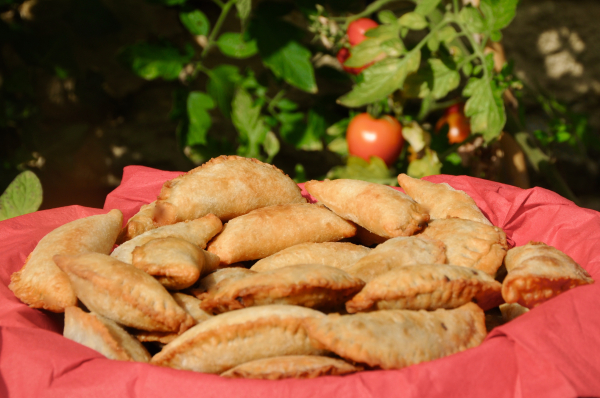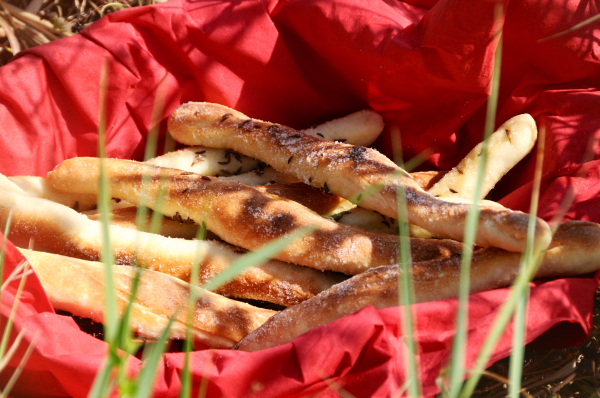During the past months a lovely Spanish neighbor has gifted me twice with fare from her home country: Salamanque ham and bottles of unfiltered wine made from hand-picked Prieto Picudo grapes. These grow in tight, pointed clusters in the Valdeleña vineyard of the Ribera del Cea, Spain.
Always eager to sample wines from lesser known grapes, I uncorked this puppy and sampled it with the Spanish ham, sliced tomato (fresh picked from her garden) and organic comte cheese. The wine is like a sweet Merlot on the nose, round in the mouth, and includes tastes of charcoal, smoke and jam. After months of drinking low-alcohol Bordeaux French wines—this packed a punch with 14 percent alcohol. Although I don’t agree with the label’s saying it has a ‘long charming aftertaste,’ it’s easy drinking, and grows on you with time.
Which is why I’ve just poured a second glass.

Aged 12 months in oak, this wine is decent to drink with red meat or charcuterie. It originates within the Castilla y León region of Spain (in the central to northwest portion of the country) and is produced by Bodega Melgarajo—which is basically a late-1990’s sustainable rural development program, now run by a group of 170 winegrowers. Incidentally, Wine Spectator Magazine mentioned this wine producer in the final paragraphs of a 2013 article.

While on the topic of Latin culture, I recently cooked a batch of 50 empanadas from a recipe provided by Lapostolle winery in the Colchagua Valley of Chile. This stunning multimillion dollar winery was carved out of a granite mountain and enables the production of gravity fed wines – inspired by French Bordeaux blends, but including the local Chilean Carmenere grape.
The production of these empanadas took plenty of preparation time, but were well appreciated by all who sampled them. A recent dinner gathering (thanks Jonathon and Danielle) included guests from the UK, Holland, South Africa, Germany, Canada, and the U.S. enjoyed these nibbles. My Spanish friend also sampled them (and approved) while seated outside our local Cave de La Citadelle wine bar with a glass of local French wine: a melding of two amazing food and wine cultures.
Here is the recipe.
Cheese and Mushroom Empanadas
From Wine Team and Winemaker Andrea León Iriarte at Casa Lapostolle, Colchagua Valley, Chile
Preparation Time and Quantity –
2 to 3 hours to prepare (depending on your speed with forming individual empanadas), and 30 minutes to fry. Makes 50 empanadas.
Ingredients and Amounts
Dough*
Vegetable shortening – 3½ ounces (100 grams)
Salt (kosher) – 1½ teaspoons (7.5 grams)
Warm water –⅔ cup (160 milliliters)
Flour – 3 cups (300 grams); plus extra for rolling out dough
Filling
Olive oil (extra virgin) – 2 tablespoons (30 milliliters)
Onion – 1⅓ cups (200 grams) [about 1¼ medium size onions]
Button mushrooms – 12 ounces (340 grams)
Dry white wine – 3 tablespoons (45 milliliters)
Egg – 1
Cheese (Gouda) – 6 ounces (170 grams)
Vegetable oil – as needed for deep-frying
Salt and fresh black pepper – to taste
* Rather than make pastry dough, you can use good quality pastry dough purchased from a store. It’s better to make your own if you have time.

Preparation –
- Remove stems from mushrooms, then dice caps.
- Dice onion.
- Beat egg and add 1 tablespoon (15 milliliters) of water.
- Shred Gouda cheese.
- Heat water.
Recipe –
Dough
- Heat vegetable shortening in a small saucepan over low heat. When it begins to melt, add salt and warm water.
- Remove from the heat and set aside.
- Put flour in a food processor. While it is running, pour half the set aside melted shortening liquid inside. Stop the processor, set to pulse, and while on pulse slowly add remaining liquid. (Alternatively, you can mix by hand in a bowl with a wooden spoon.)
- Turn dough onto lightly floured surface and knead briefly for a few minutes – until smooth.
- Form dough into a disk or a ball, wrap in plastic, and refrigerate for at least 30 minutes, until cool.
Filling
- Heat oil in a 12-inch (25 centimeter) skillet. Add onion, then sauté on medium heat until soft.
- Add mushrooms and sauté until ingredients begin to brown. Add wine and cook until liquid evaporates. Remove from heat and season with salt and pepper.
- Lightly flour a surface and roll dough out as thin as possible. Cut 3-inch (7.5 centimeter) diameter circles out of dough, saving scraps (which can be re-rolled, but only one time). The easiest way to do this is place a glass onto the rolled dough and twist.
- Place a small pinch of cheese on each circle and top with about ½ tablespoon (2 to 3 grams) of mushroom mixture, leaving a ½ inch (1 centimeter) border around the filling.
- Brush egg wash around edges and fold dough over to make a half-circle.
- Tightly crimp edges by folding them over or using fork tines.
- Heat vegetable oil in a 2-inch (5 centimeter) deep fryer, sauté pan, or wok. When the oil reaches 375 degrees Fahrenheit (190 degrees Celsius), slowly drop the empanadas inside, 6 at a time.
- Cook for a few minutes on each side, until lightly browned. Drain on paper towels and allow to cool before serving.
Serving –
Lapostolle recommends drinking Sauvignon Blanc wine with the empanadas. Alternatively any white Bordeaux blend works.
Tom’s Comments –
These are excellent and attractive vegetarian appetizers.
It takes about 1½ hours to have the dough ready to press, and ingredients all ready. Assembling the empanadas should be an assembly line process. I put three bowls before me: shredded cheese, mushroom/onion mix, and beaten egg. After putting a pinch of cheese and a half spoon of the mushroom/onion mix dead center of each dough circle – one at at time – I folded the dough over, crimped the edges, dipped the semicircular edge in the egg mixture in a rolling motion, then finally crimped each side with the tines of a small fork.
&&&
Now another recipe, taken again from the book I am assembling: The Winemakers’ Cooking Companion. These Austrian breadsticks are another appetizer/nibble to enjoy with a glass of wine.
Salzstangerl Bread Sticks
From Ariane Umathum of Umathum Wines, Frauenkirchen, Burgenland Wine Region, Austria
Preparation Time and Quantity –
15 minutes to prepare bread stick dough, 30 minutes for the dough to rise. Another 35 minutes to knead and form bread sticks, and 20 minutes to cook. Total time—1 hour 40 minutes. Makes 64 bread sticks.

Ingredients and Amounts
Flour (fine) – 2¼ pounds (1 kilogram)
Salt – 2½ teaspoons (14 grams)
Water (lukewarm) – ¼ cup (60 milliliters)
Milk – 2 cups (½ liter, or 500 milliliters)
Yeast – 1 package
Sugar – 3 tablespoons (40 grams)
Cream – ⅘ cup (200 grams)
Salt and caraway seeds – as needed
Preparation –
- Pre-heat oven to 480 degrees Fahrenheit (250 degrees Celsius), or wait until after step 2, below, to do this.
Recipe –
- Add yeast to lukewarm water with a pinch of sugar.
- In a bowl, make dough by mixing flour, salt, milk, yeast mixture, cream and sugar. Mix with a wooden spoon, then with hands. Knead for 2 to 3 minutes. Then put in an oiled bowl, cover with a towel, and leave in a moderately warm place, such as near the pre-heating oven or in sunshine. Let it rest and rise for at least half an hour.
- When dough is ready, cut into 8 parts.
- Knead each of 8 dough pieces for 2 to 4 minutes each on a floured surface such as a table. Then then cut each of the kneaded lumps, one at a time, into 8 more parts.
- To knead this dough, roll each of the lumps between your hands to make 6 to 10 inch (15 to 25 centimeter long bread sticks.
- Take each bread stick and roll it in a plate in which olive oil has been placed, then roll this oiled bread stick in another plate where salt and caraway seeds have been sprinkled. With practice, it will take about 30 seconds to coat each bread stick this way.
- Put some olive oil on a baking tray and place bread sticks on the tray. Reduce oven heat to 390 degrees Fahrenheit (200 degrees Celsius).
- Bake bread sticks for between 15 and 20 minutes.
Serving –
Ariane writes –
“To give you a typical Austrian recipe, I chose salzstangerl. They fit wonderfully with wine and are so easy to prepare. In Burgenland they are often served at wine tastings.”
Tom’s Comments –
These salty delights will keep you reaching for more, and will make you thirsty enough to reach for more wine. You can choose how long or how thick you want the sticks, though ¼ to ½ inch (⅔ to 1¼ centimeters) thick works well. The use of two plates with olive oil and with the combined salt/caraway seed mix is my idea—just to provide assembly-line efficiency to the process. The alternative is to sprinkle the sticks on the baking sheet, but unless they are oiled, the seeds will not stick.
This recipe provides plenty of breadsticks, so you can halve the recipe if you want. However, even if you halve the recipe, you will need two baking sheets.
These sticks go well with red or white wines, preferably dry rather than sweet.
###
Finally, my latest Forbes posts are here, including a tribute to winemaker Denis Dubourdieu, and a piece on how Romans enjoyed luxury in western France.




Trisha
3 Aug 2016Looks delicious! Coincidentally, just had a bottle of Lapostolle last night…!
vinoexpressions
10 Aug 2016Great! Not a bad wine with that Carmenere.
vinoexpressions
10 Aug 2016I recently received this comment in an email from my friend Denise in Calgary, Canada.
Hi Tom,
I hope that you are having a wonderful summer.
I thought you might like to know that I tried the empanadas recipe on the weekend. They turned out well, except that I didn’t do a great job rolling out the dough thinly so I only made a lot fewer than expected. Not a problem though. They were delicious!
Thanks for the recipe.
Denise